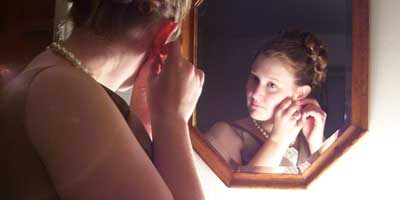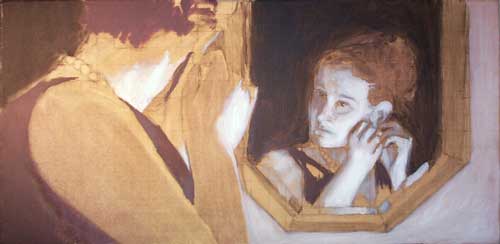Underpainting Techniques – A New Experiment
As a change of pace, I decided to take a break from obsessing over Bargue and work on some oil painting. I’ve currently got a painting started that I feel has a lot of potential if I don’t screw it up in the process. A few months ago my wife was a bridesmaid in a friend’s wedding. She had on a simple but elegant dress and had her hair styled up very nicely. Needless to say – she was looking good… After we came home from the reception, I thought that I should take some photos of her for some future art projects that had yet to be developed. I had her pose for me in our living room for a few shots with interesting lighting. One of the photos eventually became a full-length figure painting that you can see on my fine art page. There was another shot that I really liked and thought had potential to be used in some way. Coincidentally, I had a canvas that I had bought years earlier because I liked the shape – a 15″ x 30″ long rectangle – but hadn’t yet figured out what to paint on it. One day, as I was experimenting with different ways to crop the photo of my wife, I came up with a really interesting composition using the proportions of my unused canvas.

While I was considering how to go about painting this picture, I was reading the book Traditional Oil Painting: Advanced Techniques and Concepts from the Renaissance to the Present by Virgil Elliott, a really wonderful book that launched my understanding of the Old Master’s techniques into new realms. In it I learned about the techniques of grisaille (French) and verdaccio (Italian) – two techniques for underpainting that have their own unique methods, but achieve a similar result – essentially creating a monochrome painting consisting only of values of black & white (with dark green in verdaccio) and then applying thin, transparent glazes of color over top. The idea is to separate the steps of color and value into two separate parts of your painting process, allowing you to make sure the values are correct before proceeding on to worrying about the hue and chroma of your colors. My opinion – oil painting is hard enough as it is, and I welcomed the idea of breaking a painting down into manageable bits, so I decided to try it out using a black & white grisaille.

The Process Thus Far
After toning the canvas with a light wash of umber, I used a grid overlay to transfer the composition from the photo. I then blocked in the shadows with mixtures of black & umber and added some highlights in white. After reading a bit more, I decided to go completely with a gray opaque underpainting so I could focus more on value than color.

As of this writing I’ve got the hardest part done – the portrait – and I’m pretty pleased with the progress. The next step will be to completely finish the grisaille – then I’ll be ready to deal in glazes of color.
While working on this painting I’ve noticed that I have moved much more slowly and patiently, making sure to get the face and the likeness right before I moved on. I spent a long time just looking at the painting from a distance and in a mirror to make sure that the proportions also looked right in reverse. The reason I point this out is that it’s not my usual way of working… I usually get fairly close to my reference, but my impatience inevitably wins out and the piece ends up not being as good as it could have been had I been more careful. I am beginning to believe that the Bargue exercises are doing me some good, even though I’ve only just begun. Deep down I know that I have the ability to do masterful work – I just sometimes lack the discipline to carry it through to completion. Hopefully I’m turning a corner here…
